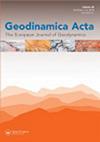新西兰陶波火山带西部热液黄铁矿中金的赋存状态
IF 1.5
Q1 Earth and Planetary Sciences
引用次数: 12
摘要
新西兰北岛的陶波火山带(Taupo Volcanic Zone, TVZ)位于俯冲的太平洋板块之上,孕育着与俯冲、弧岩浆活动和地壳伸展有关的热液系统。在这些系统中,黄金主要以硫化物配合物的形式运输,随着深层地热流体的沸腾和混合,黄金被沉积下来。TVZ西部的特鲁克河上游砾岩卵石和热液喷气孔是附近中新世冲积沉积高原侵蚀形成的矿化矿床。晚期热液作用在砾岩和喷气孔中沉淀了丰富的含金黄铁矿,黄铁矿主要以细脉状、浸染状和细粒聚集体的形式存在,形成离散的自面体微晶。扫描电镜结合x射线能谱分析表明,黄铁矿受晚期热液流体的影响较大,可能受碳酸盐流体的影响。电子探针微量分析表明,黄铁矿含金20 ~ 120 ppm(平均60 ppm)。波长色散谱元素映射表明,金在黄铁矿中均匀分布,表明黄铁矿中存在结构束缚金(固溶体)。在砾岩和喷气孔中发现的金矿化表明,雷斯鲁克河上游是未来金矿勘探的有利目标。本文章由计算机程序翻译,如有差异,请以英文原文为准。
Occurrence of gold in hydrothermal pyrite, western Taupo Volcanic Zone, New Zealand
The Taupo Volcanic Zone (TVZ) on the North Island of New Zealand is located above the subducting Pacific slab and hosts hydrothermal systems related to subduction, arc magmatism and crustal extension. In these systems, gold is transported primarily as sulphide complexes, with gold being deposited in response to boiling and mixing of the deep geothermal fluids. Conglomerate cobbles and hydrothermal fumaroles from the upper Retaruke River in the western TVZ are mineralised deposits that have been eroded from the nearby Miocene alluvial sedimentary plateau. Abundant gold-bearing pyrite was precipitated in the conglomerates and fumaroles by late hydrothermal process, primarily occurring as veinlets, disseminations and fine-grained aggregates which consists discrete euhedral microcrystals. Scanning electron microscopy combined with X-ray energy disperses spectroscopy shows that pyrites are commendably affected by late hydrothermal fluids, possibly by the carbonate fluid. Electron probe microanalysis revealed that the pyrite contains 20–120 ppm Au (averaging 60 ppm). Wavelength dispersive spectral elemental mapping suggests that gold is distributed uniformly in pyrite, indicating structurally bound gold (solid solution) in pyrite. Gold mineralisation recognised in the conglomerates and fumaroles demonstrates that the upper Retaruke River is a promising target for future gold exploration.
求助全文
通过发布文献求助,成功后即可免费获取论文全文。
去求助
来源期刊

Geodinamica Acta
地学-地球科学综合
CiteScore
4.50
自引率
0.00%
发文量
0
审稿时长
25 weeks
期刊介绍:
Geodinamica Acta provides an international and interdisciplinary forum for the publication of results of recent research dealing with both internal and external geodynamics. Its aims to promote discussion between the various disciplines that work on the dynamics of the lithosphere and hydrosphere. There are no constraints over themes, provided the main thrust of the paper relates to Earth''s internal and external geodynamics. The Journal encourages the submission of papers in all fields of earth sciences, such as biostratigraphy, geochemistry, geochronology and thermochronology, geohazards and their societal impacts, geomorphology, geophysics, glaciology, igneous and metamorphic petrology, magmatism, marine geology, metamorphism, mineral-deposits and energy resources, mineralogy, orogeny, palaeoclimatology, palaeoecology, paleoceanograpgy, palaeontology, petroleum geology, sedimentology, seismology and earthquakes, stratigraphy, structural geology, surface processes, tectonics (neoteoctonic, plate tectonics, seismo-tectonics, Active tectonics) and volcanism.
Geodinamica Acta publishes high quality, peer-reviewed original and timely scientific papers, comprehensive review articles on hot topics of current interest, rapid communications relating to a significant advance in the earth sciences with broad interest, and discussions of papers that have already appeared in recent issues of the journal. Book reviews are also included. Submitted papers must have international appeal and regional implications; they should present work that would be of interest to many different specialists. Geographic coverage is global and work on any part of the world is considered. The Journal also publishes thematic sets of papers on topical aspects of earth sciences or special issues of selected papers from conferences.
 求助内容:
求助内容: 应助结果提醒方式:
应助结果提醒方式:


